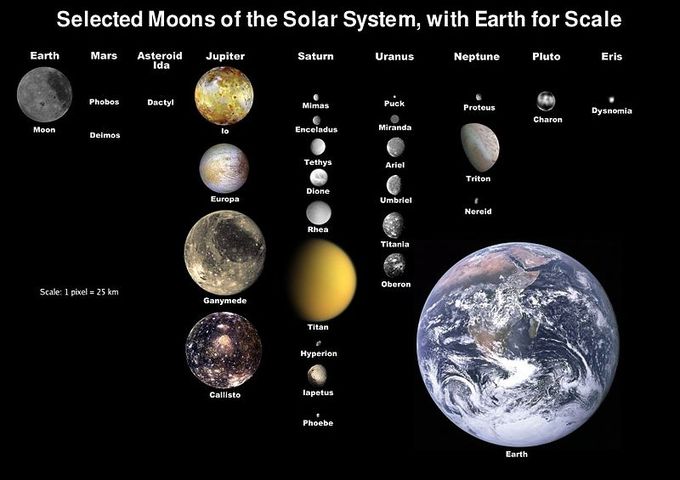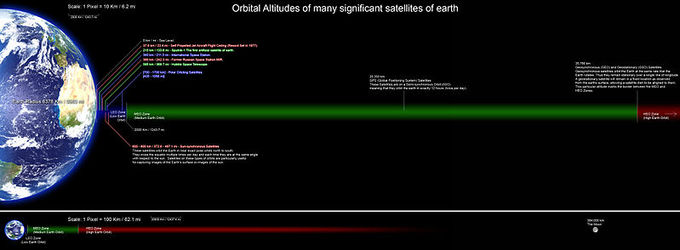Kepler’s First Law
Kepler’s first law is: The orbit of every planet is an ellipse with the Sun at one of the two foci.
Learning Objectives
Apply Kepler’s first law to describe planetary motion
Satellites
Natural satellites are celestial objects that orbit a larger body; artificial satellites are manmade objects put in the orbit of the Earth.
Learning Objectives
Define the concept of a satellite, in the broadest possible terms
Key Takeaways
Key Points
- The broadest possible definition of a satellite is an object that orbits a larger one due to the force of gravity.
- All satellites follow the laws of orbital mechanics, which can almost always be approximated with Newtonian physics.
- Natural satellites are often classified in terms of their size and composition, while artificial satellites are categorized in terms of their orbital parameters.
- Artificial Earth-orbiting satellites have orbits categorized by their altitudes, inclinations, and eccentricities.
Key Terms
- natural satellite: A natural satellite, moon, or secondary planet is a celestial body that orbits a planet or smaller body, which is called its primary.
- artificial satellite: In the context of spaceflight, a satellite is an object which has been placed into orbit by human endeavour.
Satellites
The word “satellite” has a somewhat ambiguous definition. The broadest possible definition of a satellite is an object that orbits a larger one due to the force of gravity. Natural satellites, often called moons (see ), are celestial bodies that orbit a larger body call a primary (often planet, though there are binary asteroids, too). It is technically correct to refer to a planet as a “satellite” of its parent star, though this is not common.

Moons of the Solar System: Nineteen natural satellites are large enough to be round, and one, Saturn’s Titan, has a substantial atmosphere.
Artificial satellites (see ) are man made objects put in orbit about the Earth or another planet in the Solar System. All satellites follow the laws of orbital mechanics, which can almost always be approximated with Newtonian physics.

Orbital Altitudes: Orbital Altitudes of several significant satellites of earth.
Natural satellites are often classified in terms of their size and composition, while artificial satellites are categorized in terms of their orbital parameters.
Natural Satellites
Formally classified natural satellites, or moons, include 176 planetary satellites orbiting six of the eight planets, and eight orbiting three of the five IAU-listed dwarf planets. As of January 2012, over 200 minor-planet moons have been discovered. There are 76 objects in the asteroid belt with satellites (five with two satellites each), four Jupiter trojans, 39 near-Earth objects, and 14 Mars-crossers. There are also 84 known natural satellites of trans-Neptunian objects. Planets around other stars are likely to have natural satellites as well, although none have yet been observed.
Of the inner planets, Mercury and Venus have no natural satellites; Earth has one large natural satellite, known as the Moon; and Mars has two tiny natural satellites, Phobos and Deimos. The large gas giants have extensive systems of natural satellites, including half a dozen comparable in size to Earth’s Moon: the four Galilean moons, Saturn’s Titan, and Neptune’s Triton. Saturn has an additional six mid-sized natural satellites massive enough to have achieved hydrostatic equilibrium, and Uranus has five. It has been suggested that some satellites may potentially harbor life, though there is currently no direct evidence.
The Earth–Moon system is unique in that the ratio of the mass of the Moon to the mass of the Earth is much greater than that of any other natural satellite to planet ratio in the Solar System. Additionally the Moon’s orbit with respect to the Sun is always concave.
The seven largest natural satellites in the Solar System (those bigger than 2,500 km across) are Jupiter’s Galilean moons (Ganymede, Callisto, Io, and Europa), Saturn’s moon Titan, Earth’s moon, and Neptune’s captured natural satellite Triton.
Artificial Satellites
The first satellite, Sputnik 1, was put into orbit around Earth and was therefore in geocentric orbit. By far this is the most common type of orbit with about 2,500 artificial satellites orbiting the Earth. Geocentric orbits may be further classified by their altitude, inclination and eccentricity.
The commonly used altitude classifications are Low Earth orbit (LEO), Medium Earth orbit (MEO) and High Earth orbit (HEO). Low Earth orbit is any orbit below 2000 km, and Medium Earth orbit is any orbit higher than that but still below the altitude for geosynchronous orbit at 35,786 km. High Earth orbit is any orbit higher than the altitude for geosynchronous orbit.
Altitude classifications
- Low Earth orbit (LEO): Geocentric orbits ranging in altitude from 0–2000 km (0–1240 miles)
- Medium Earth orbit (MEO): Geocentric orbits ranging in altitude from 2,000 km (1,200 mi) to just below geosynchronous orbit at 35,786 km (22,236 mi). Also known as an intermediate circular orbit.
- High Earth orbit (HEO): Geocentric orbits above the altitude of geosynchronous orbit 35,786 km (22,236 mi).
Inclination Classifications
- Inclined orbit: An orbit whose inclination in reference to the equatorial plane is not zero degrees.
- Polar orbit: An orbit that passes above or nearly above both poles of the planet on each revolution. Therefore it has an inclination of (or very close to) 90 degrees.
- Polar sun synchronous orbit: A nearly polar orbit that passes the equator at the same local time on every pass. Useful for image taking satellites because shadows will be nearly the same on every pass.
Eccentricity Classifications
- Circular orbit: An orbit that has an eccentricity of 0 and whose path traces a circle.
- Hohmann transfer orbit: An orbital maneuver that moves a spacecraft from one circular orbit to another using two engine impulses.
- Elliptic orbit: An orbit with an eccentricity greater than 0 and less than 1 whose orbit traces the path of an ellipse.
- Geosynchronous transfer orbit: An elliptic orbit where the perigee is at the altitude of a Low Earth orbit (LEO) and the apogee at the altitude of a geosynchronous orbit.
- Geostationary transfer orbit: An elliptic orbit where the perigee is at the altitude of a Low Earth orbit (LEO) and the apogee at the altitude of a geostationary orbit.
Candela Citations
- Curation and Revision. Provided by: Boundless.com. License: CC BY-SA: Attribution-ShareAlike
